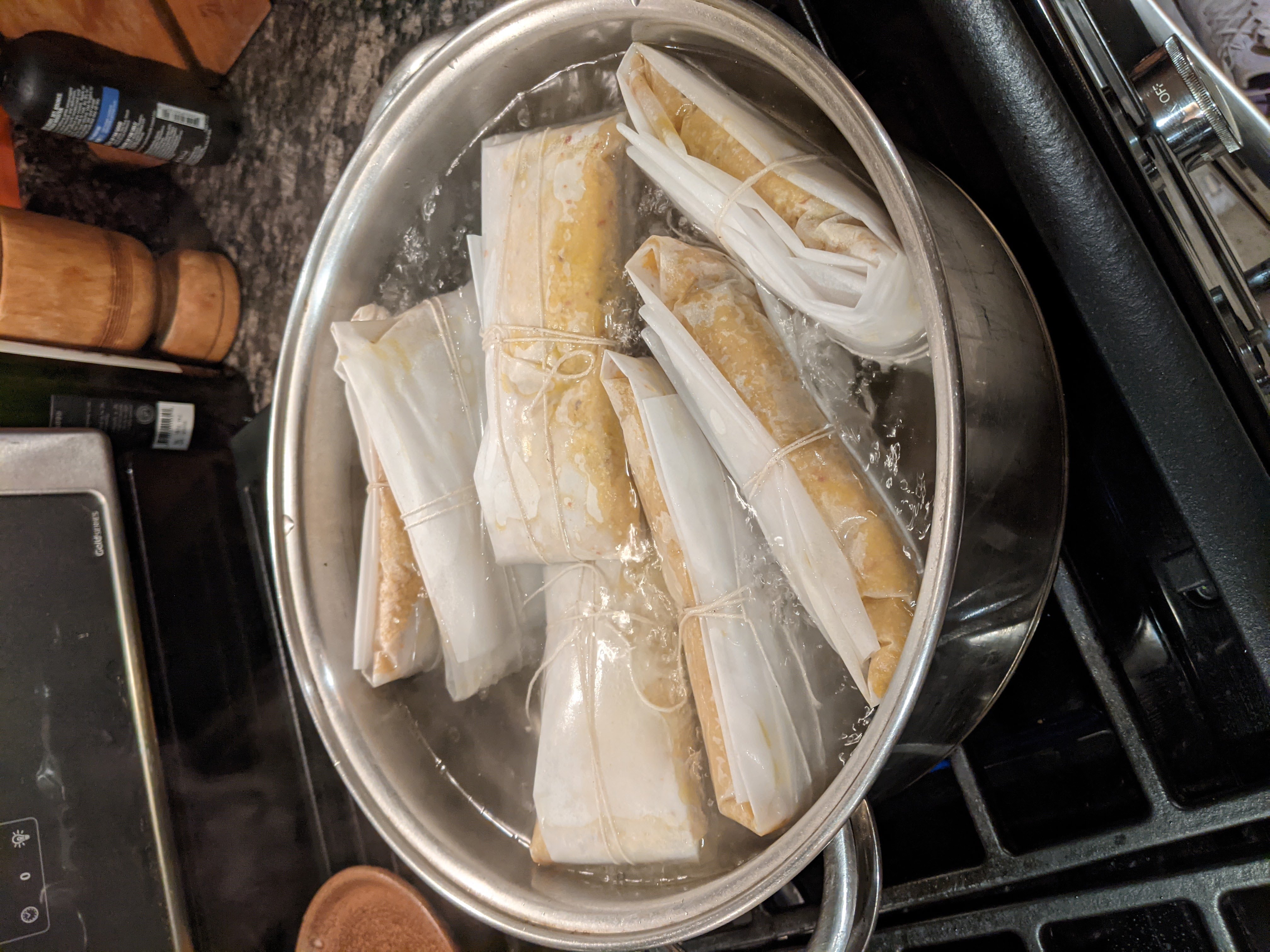
Pasteles
Details
Pasteles are a production to make. Expect to spend half the day making these tasty tamal-like pouches.
Ingredients
Masa
- Green Bananas 30%
- Plantains (green) 15%
- Squash (or Kabocha) 30%
- Yuca 15%
- Potatoes (Yukon Gold) 10%
Filling
- pork leg (w/ one big bone), chicken, or impossible beef) guisado in sofrito
Pouch
- achiote oil (tomato paste + olive oil simmered)
- parchment paper (12”x18”) sheets
- String (for tying up the pasteles)
- banana leaf (optional)
Preparation:
Masa
-
Shred all of the plantains, bananas, squash, potatoes, and yuca. Mix together so the various vegetables are evenly distributed.
-
Food process everything into a paste. Add water or milk tablespoon at at time to get desired texture. Should be a yellow paste with slight orange tinge.
Assembly
-
Make an oil mixture heated with some tomato paste - achiote oil. Can add achiote if desired as well.
-
On a large, clean work surface, set up your pastel-making station: You will need the banana leaves, parchment paper, string, the annatto oil, the pork and its liquid, and the masa. To make each pastel, start with a piece of parchment paper in front of you, one long side closest to you. Use a soup spoon or a pastry brush to paint a very thin smear of annatto oil on the parchment paper, leaving a 2-inch border on the top and bottom and 4 inches on the sides. (This does not have to be perfect: It’s just to keep the banana leaf from sticking.) Lay the banana leaf down on top of the oil, long side closest to you. Paint the banana leaf very lightly with the annatto oil. Spread 1/2 cup of masa on top of the banana leaf about 3/4 to 1/2 inch thick. The masa does not have to be a perfect shape: It can overlap the leaf in places and does not have to cover it completely.
-
Spoon a scant 1/4 cup of pork pieces along the length of the masa in a straight line. Your goal is really a line of pork chunks along the center of the masa, so that each bite of pastel has a bite of pork. Use a spoon to drizzle on a little more sauce as needed so that most of the masa is covered by a very thin layer of liquid. Don’t overdo it: About a tablespoon or so of liquid per pastel is about right.
-
To form the pastel, fold the parchment paper in half, from the bottom up, over the masa and filling so the 2 long edges meet. Fold those edges down to meet the edge of the pastel farthest from you. Press the paper down and crease the top edge. Smoosh the pastel back into the folded section to make it nice and thick. Fold the parchment in half again lengthwise from the top down, so it covers the pastel. You now have a long thin pastel wrapped in a tube of parchment, with multiple layers of paper on top. (This needn’t be exact, as long as the paper forms a neat little package.) Working carefully, use the side of your hand to press and slide the masa on either side of the package into the center to give it a neat edge. Fold in 1 inch of the paper on the left and right sides to create small hems. Then fold both sides over the pastel. (If you have a few leaks, it’s O.K.) Set this pastel aside, flaps facing downward, while you make its partner: Repeat the process above to make a second pastel.
-
When you have 2 pasteles, stack them together so they line up, flaps facing inward. Use 1 piece of string to tie the pasteles together the same way you would a package, looping the string once across the long way and at least once across the short way. Make sure the string is tight and the pasteles are tightly tied together. Repeat this process with the remaining pairs of pasteles. At this point they can be frozen for several months, refrigerated for a day or two, or cooked and eaten immediately.
Cooking the Pasteles
- To cook them, bring a large pot (or a few pots) of salted water to a boil and add the pasteles, either fresh or frozen, in a single layer. Let cook for 1 hour, or an hour and 10 minutes or so if they are frozen. Repeat with the remaining pasteles, then unwrap and serve right away.